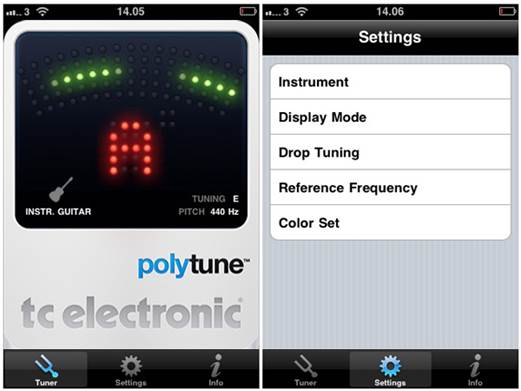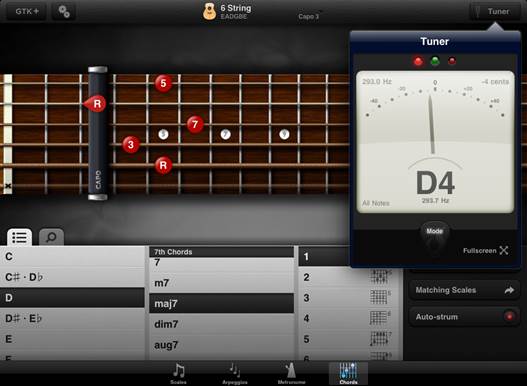Smartphones and tablets are a boon to
musicians. These minicomputers can be used to capture high-resolution audio,
video, and photos at a gig; organize and display a library of printed music;
help us connect with fans; and monetize our work. One of the most popular
mobile platform is Apple iOS, which runs on the iPad, iPhone, and iPod Touch.
Hundreds of software developers have created task-specific applications (apps)
for iOS. There are apps for every musical endeavor – learning, teaching,
rehearsing, composing, and recording and the majority of them cost less than a
pack of strings. In fact, some of die best apps are free.

Smartphones
and tablets are a boon to musicians
But don’t select an app solely on cost:
price doesn’t necessarily determine the quality or usefulness of an app. If
your choice is between a free tuner that you’ll rarely open and one that costs
$4.99 and has features you’ll take advantage of, make the investment.
Ultimately, die app you choose for a given task will depend on whether it
matches your work methods and budget. And with many products costing less than
%5, the financial risk of trying something new is low.
Get organized
With thousands of music-related apps
available, it’s easy to clutter your home screen by accumulating products
you’ll never use. To help you determine the tools you’ll need, I’ve organized this
article into categories and picked a couple of standout apps in each, to show
the kinds of features that are typically offered. However, this is by no means
an exhaustive list, because new apps are being released all die time.

The
number of folders you create will depend on the quantity and types of apps you
have
As you accumulate apps, it helps to put
them into folders with similar apps so you can easily find the one you want.
The number of folders you create will depend on the quantity and types of apps
you have. I created a folder called MusicTools on my home screen that contains
only the dozen products I use most – an audio recorder, a tuner, a metronome,
virtual amps, a scheduler, a sales tool, etc. However, I didn’t want to delete
any of the other apps I’ve collected, so I organized diem by type into
additional folders – Music2 (tuners, metronomes, notation readers, amps) and
Recording.
If your device has a reasonably updated iOS
(version 5 or 6), you should have no problem using the products listed in this
article. Before you purchase any app, however, be sure to read the system
requirements to make sure they are compatible with your specific device (not
every product supports the iPod Touch, for example), and read die ratings to
see the kinds of troubles users have experienced.
As you shop, check that the features listed
are available in die version you’re purchasing. Some developers offer extra
content or features as an in-app purchase for an additional fee, and some
products list diese premium features as if they were part of the basic package.
Practice and performance
Let’s start with basic tools that musicians
use most tuners and metronomes. One nice tiling about having a tuner app is
that you don’t have to plug your instrument into anything to use it. The
built-in microphone is sensitive enough that you can be a foot or more away
from the mie and it’ll easily hear you. If you’re amplified, you can even leave
the iOS device on the amp and peek at it between songs to check your
intonation.

PolyTune
supports dropped tunings, has two metering modes and a selectable reference
frequency, and it works with bass, too
But be sure you don’t place your iDevice in
such a way that you cover the microphone. And if you are onstage or in die
studio and your device has mobile network capabilities, switch it into Airplane
mode. That way you won’t receive calls and texts during a gig or session, and
die amps and PA equipment won’t pick up that annoying beeping noise as it seeks
reception.
There are a number of free standalone
tuners available, such as GuitarTuna and ?-Track Tuner (ntrack.com) that
are simple and work well. But my favorite is TC Electronic’s PolyTune ($4.99),
the app version of the company’s slick Stompbox Tuner. Strum all six open
strings of your guitar and the app will show you which ones are out of tune.
PolyTune supports dropped tunings, has two metering modes and a selectable
reference frequency, and it works with bass, too.
Another winner is the Cleartune Chromatic
1/iner (3.99), which features a note-wheel display that is accurate to +-1
cent, a tone generator, transposition, and adjustable calibration. It even
provides different tuning temperaments. The company also sells a well-designed
metronome app, Clockwork ($0.99) with a unique feature: you can use it to
create complex click tracks that include tempo changes.
If you’re looking for a classic, no-frills
metronome, the Keaka Jackson Metronome (free) features a swinging pendulum.
Pull the arm to one side to start, and tap to stop. It has only three time
signatures, but hey, it’s free!

For
an all-in-one app, Agile Partners’ GuiatrToolkit is hard to beat
For an all-in-one app, Agile Partners’
GuiatrToolkit ($9.99) is hard to beat. It starts with a quality tuner that
supports open and custom timings and includes a metronome as well as a
substantial library of chords, scales, and arpeggios. You can create a
customized instrument (six-, seven-, and 12-string guitars; bass; ukulele;
banjo; mandolin), make it left-handed, add a capo, and the graphics will match
your scale/chord section. For an additional $2.99, you can upgrade to
GuitarToolkit+, which lets you create, e0mail, and print chord sheets and
includes a drum machine-style metronome. It’s die best $12.99 you’ll spend on
an app.
For practicing and transcribing, nothing
beats the Amazing Slow Downer ($14.99). The app lets you play an audio file at
speeds ranging from 25 percent to 200 percent without changing the pitch, and
you can set loop points, change playback pitch +-12 semitones, and add EQ to
help parts stand out.